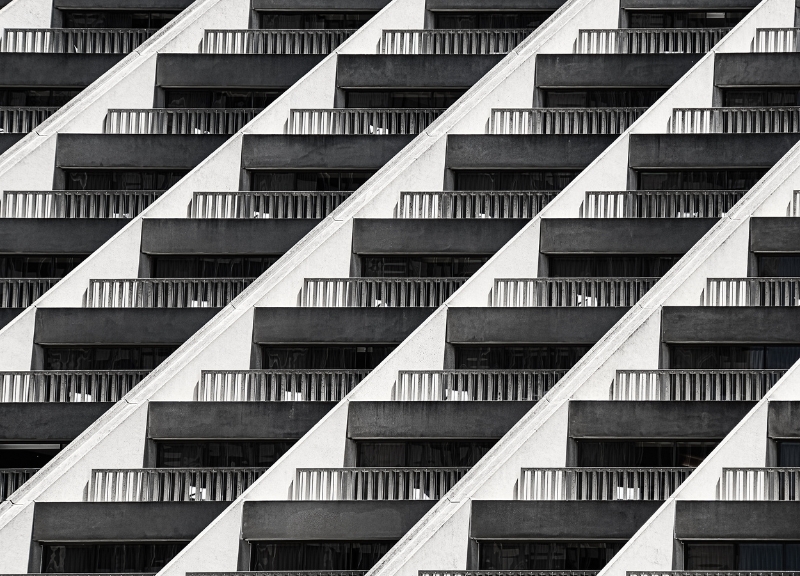
Framing the Built Environment: Glenn Goldman on His AMP Exterior Photography Triumphs

Glenn Goldman, architect, educator, and photographer at the New Jersey Institute of Technology, has been honored in the Architectural Photography – Exterior category for four winning images—Getty Center: Tableaux (Cultural Exterior), Gateway, Palace of Fine Arts (Historic Exterior), Hyatt Balconies, and Four Bars (Exterior Details)—alongside multiple honorable mentions. We spoke with Glenn about his dual passion for architecture and photography, his creative process, and how his work encourages viewers to see familiar structures anew.
How did your journey as an architect lead you into architectural photography?
Glenn Goldman: Photography and building design have always fascinated me. As a freshman studying architecture, art-history photographs of iconic structures captured my imagination—and often woke me up before dawn. I began documenting buildings to build a personal visual library. Over time, that collection became my creative focus. Today, I draw on my architectural training to frame photos that highlight design details and broader compositions.
With four winners in 2024, what united these images conceptually?
Glenn Goldman: Each image—whether the clean symmetry of Getty Center: Tableaux, the time-worn grandeur of the Gateway, Palace of Fine Arts, or the rhythmic patterns in Hyatt Balconies and Four Bars—reveals compositional elements we often overlook. My aim was to celebrate how light, form, and texture converge, turning even everyday façades into artful abstractions.

Can you walk us through your photography process from capture to final image?
Glenn Goldman: It begins with data capture—selecting perspectives, exposures, and timing to record on the camera’s sensor. Then comes the post-production: I process the RAW files to reflect what I saw (or remember seeing), deciding in that moment whether to render the scene in black and white. My architectural background guides me in emphasizing lines, symmetries, and visual rhythms using software, without straying from reality.
What challenges did you face in creating these exterior photographs?
Glenn Goldman: Access and timing are the biggest hurdles—reaching precise vantage points, coordinating travel, and working around unpredictable weather. Deciding on black-and-white early in post helps me distill each image to its essential shapes and textures. Occasionally, a sudden storm or unique light presents an unforeseen opportunity to capture something truly special.
Which outcome of this year’s winners are you most proud of?
Glenn Goldman: I’m proud that these photographs prompt viewers to notice architectural details they might otherwise pass by—symmetries, visual textures, and layered spaces. It’s gratifying to be part of a movement that recognizes architectural photography as an art form in its own right.
How do your roles as architect and educator influence your photographic eye?
Glenn Goldman: Teaching basic design—color, composition, form—keeps me attuned to the principles that make structures compelling. Working with students and practicing as an architect have sharpened my ability to isolate design elements in my images, while my mentors (like Urs Gauchat, Moshe Safdie, Robert A.M. Stern, and Michael McKinnell) taught me to trust my vision.
With AI reshaping visual media, how do you see photographic practice evolving?
Glenn Goldman: AI is integral to digital post-processing, from dynamic-range adjustments to noise reduction. The key question is how far we let algorithms alter our images. For now, I use AI tools to achieve what my eyes perceived, ensuring the final photograph remains a faithful celebration of human-made design.
In what ways can architectural photography make a meaningful social impact?
Glenn Goldman: Photographs frame collective memory and draw attention to our built heritage. By showcasing beauty in everyday architecture, we inspire viewers to seek out and appreciate their environments. My images also serve as teaching tools, illustrating design principles to the next generation of architects and photographers.
What does winning multiple AMP awards mean for you and your work?
Glenn Goldman: As an architect at a research-focused university, AMP recognition validates the creative side of my profession. Having four winners and several honorable mentions this year—and one winner last year—reinforces the importance of celebrating fine architectural photography and motivates me to continue exploring and sharing our built world through the lens.

We thank Glenn Goldman for sharing his insights into architectural photography and for illuminating the hidden artistry in exterior forms. His award-winning images challenge us to look closer, appreciate design details, and see the interplay of light and structure in new ways.